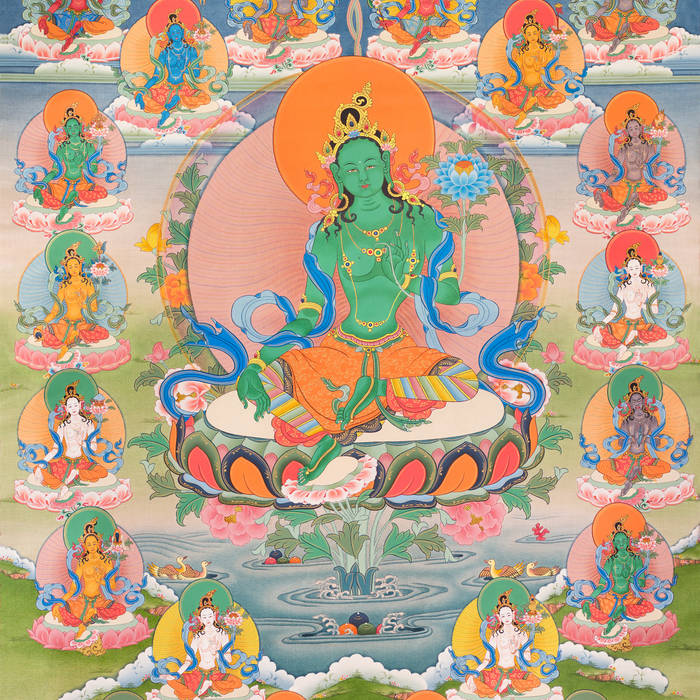The Trikaya is a fundamental doctrine within Mahayana and Vajrayana Buddhism that delineates the multidimensional nature of a Buddha's existence. This concept posits that a Buddha has three distinct bodies or aspects, each representing a different facet of enlightenment. Trikaya (Sanskrit: three bodies), in Mahayana Buddhism, is the concept of the three bodies, or modes of being, of the Buddha:
1) Dharmakaya (body of essence)
2) Sambhogakaya (body of enjoyment)
3) Nirmanakaya (body of transformation)
Why is Trikaya important? In essence, the Trikaya doctrine offers a profound framework for understanding the diverse dimensions of Buddhahood. It demonstrates how a Buddha can simultaneously exist in multiple realms and embody a spectrum of qualities, guiding practitioners towards liberation and awakening through various aspects of their being.
What is the Trikaya symbol?
The Gankyil is a symbol and ritual tool in Tibetan Buddhism. In the Bon and Nyingma Dzogchen lineages, the Gankyil is the principal symbol and teaching tool; it is symbolic of primordial energy and represents the central unity and indivisibility of all the teaching, philosophical, and doctrinal trinities in Dzogchen. It is an attribute of the snow lion.
What is Sambhogakaya in Buddhism?
Sambhogakaya is defined as a 'form body' (rupakaya) of a Buddha, which appears only to Bodhisattvas and is the basis for the arising of the Nirmanakaya. It is adorned with major signs and minor marks.
Sambhogakaya is the celestial body of the Buddha to which contemplation can ascend. In the heavenly regions, or Pure Lands, the enjoyment body teaches the Bodhisattva doctrines that are unintelligible to those who are unenlightened.
Sambhogakaya is the dimension of complete enjoyment, the field of total plenitude, beyond dualistic limitations and beyond space and time.
What is the difference between Dharmakaya and Sambhogakaya?
Dharmakaya is like the sun, and Sambhogakaya is like the rays, and nirmanakaya is like the rays hitting the objects on the earth. Nirmanakaya is the physical situation, and Sambhogakaya and dharmakaya are the levels of mind.
What is the sambhogakaya of Shakyamuni? Sambhogakaya is the body of enjoyment, or the body that experiences the fruits of Buddhist practice and the bliss of enlightenment. Some teachers compare dharmakaya to vapour or atmosphere, Sambhogakaya to clouds, and Nirmanakaya to rain. Clouds are a manifestation of the atmosphere that enables rain.
What is the nature of sambhogakaya?
Sambhogakaya : The Body of Enjoyment
The body of communication, bliss, and the play of energy, in which the enlightened mind manifests, are the five wisdoms. As the bridge between the formless and the material, Sambhogakaya is the realm of what is called “nonmaterial spiritual reality.”
The celestial manifestations of Sambhogakāya
Sambhogakaya is a "subtle body of limitless form. Buddhas such as Bhaisajyaguru and Amitbha, as well as advanced Bodhisattvas such as Avalokiteśvara and Manjusri, can appear in an enjoyment body. A Buddha can appear in an "enjoyment body" to teach bodhisattvas through visionary experiences.
Those Buddhas and Bodhisattvas manifest themselves in their specific pure lands. These worlds are created for the benefit of others. In those lands, it is easy to hear and practice the Dharma. A person can be reborn in such a pure land by "the transfer of some of the huge stock of'merit' of a land's presiding Buddha, stimulated by devout prayer.
One of the places where the Sambhogakaya appears is the extra-cosmic realm, or pure land, called Akanistha. This realm should not be confused with the akanistha of the pure abodes, for it is a realm that completely transcends it.
Absolutely seen, only Dharmakāya is real; Sambhogakaya and Nirmanakāya are "provisional ways of talking about and apprehending it.
Donations for our Buddhist research and development
Do you earnestly cherish our devoted work? Assuming this is the case, we are delighted that you are finding our blog useful and valuable. Would you consider making a donation for our Buddhist research and development?
We need your help to secure the future of scholarly interaction with Buddhism. Since our very first publication of Dharma works and activities in 2008, we have been effortlessly providing free distribution of Dharma posts and articles throughout the previous 14 years. We have exceptionally constrained support and do not receive subsidies or funding from people in general.
Please help us develop our Dharma activities that will not only benefit you but all Dharma readers on the planet. Please consider showing your support. Your generosity will certainly help us enhance our work and accomplish more for a better and brighter future.
Thank you for reading. May you find peace and great bliss. With your support, it helps to spread the Buddha’s precious teachings and turn the Dharma wheels in the world.
Aspiration For Bodhichitta
For those in whom the precious Bodhichitta has not arisen
May it arise and not decrease.
But increase further and further.
Dedication of Merit
By this merit, may we then obtain omniscience then.
Having defeated the enemies wrongdoings
May we liberate migratory from the ocean of existence.
With its stormy waves of birth, old age, sickness, and death.
*Note
I do not own or infringe any copyright on the picture(s).
Picture(s) courtesy and credit to the rightful distributors and/or studios
The picture(s) are intended for editorial use only.







No comments:
Post a Comment
Note: Only a member of this blog may post a comment.